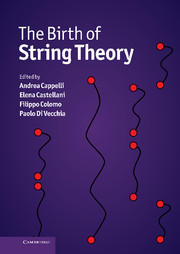Book contents
- Frontmatter
- Contents
- List of contributors
- Photographs of contributors
- Preface
- Abbreviations and acronyms
- Part I Overview
- EARLY STRING THEORY
- Part II The prehistory: the analytic S-matrix
- Part III The Dual Resonance Model
- 10 Introduction to Part III
- 11 From the S-matrix to string theory
- 12 Reminiscence on the birth of string theory
- 13 Personal recollections
- 15 Early string theory at Fermilab and Rutgers
- 15 Dual amplitudes in higher dimensions: a personal view
- 16 Personal recollections on dual models
- 17 Remembering the ‘supergroup’ collaboration
- 18 The ‘3-Reggeon vertex’
- Part IV The string
- TOWARDS MODERN STRING THEORY
- Part V Beyond the bosonic string
- Part VI The superstring
- Part VII Preparing the string renaissance
- Appendix A Theoretical tools of the Sixties
- Appendix B The Veneziano amplitude
- Appendix C From the string action to the Dual Resonance Model
- Appendix D World-sheet and target-space supersymmetry
- Appendix E The field theory limit
- Index
12 - Reminiscence on the birth of string theory
from Part III - The Dual Resonance Model
Published online by Cambridge University Press: 05 May 2012
- Frontmatter
- Contents
- List of contributors
- Photographs of contributors
- Preface
- Abbreviations and acronyms
- Part I Overview
- EARLY STRING THEORY
- Part II The prehistory: the analytic S-matrix
- Part III The Dual Resonance Model
- 10 Introduction to Part III
- 11 From the S-matrix to string theory
- 12 Reminiscence on the birth of string theory
- 13 Personal recollections
- 15 Early string theory at Fermilab and Rutgers
- 15 Dual amplitudes in higher dimensions: a personal view
- 16 Personal recollections on dual models
- 17 Remembering the ‘supergroup’ collaboration
- 18 The ‘3-Reggeon vertex’
- Part IV The string
- TOWARDS MODERN STRING THEORY
- Part V Beyond the bosonic string
- Part VI The superstring
- Part VII Preparing the string renaissance
- Appendix A Theoretical tools of the Sixties
- Appendix B The Veneziano amplitude
- Appendix C From the string action to the Dual Resonance Model
- Appendix D World-sheet and target-space supersymmetry
- Appendix E The field theory limit
- Index
Summary
Abstract
These are my personal impressions of the environment in which string theory was born, and what the important developments affecting my work were during the hadronic string era, 1968–1974. I discuss my motivations and concerns at the time, particularly in my work on loop amplitudes and on closed strings.
Introduction
It is not unusual in theoretical physics for conceptual frameworks to ride roller-coasters, but few have had as extreme highs and lows as string theory from its beginnings in 1968 to the present. In fact, string theory was so dead in the mid to late Seventies that it is a common assumption of many articles in the popular press, and of many younger string theorists, that the field originated in the Eighties, completely ignoring the period we are discussing here, which is primarily 1968–1974. So it was pleasantly surprising to be invited to reminisce about the early days of string theory. Research results from that era have been extensively presented and reviewed, so I will try to give my impression of the atmosphere at the time, and what questions we were trying to settle, rather than review the actual results.
The placenta
In themid-Sixties, the framework for understanding fundamental physics was very different from what it is now. We still talk about the four fundamental interactions, but we know that the weak and electromagnetic interactions are part of a unified gauge field theory, that strong interactions are also described by a gauge field theory which might quite possibly unify with the others at higher energy, and that even general relativity is a form of gauge field theory.
- Type
- Chapter
- Information
- The Birth of String Theory , pp. 179 - 190Publisher: Cambridge University PressPrint publication year: 2012

